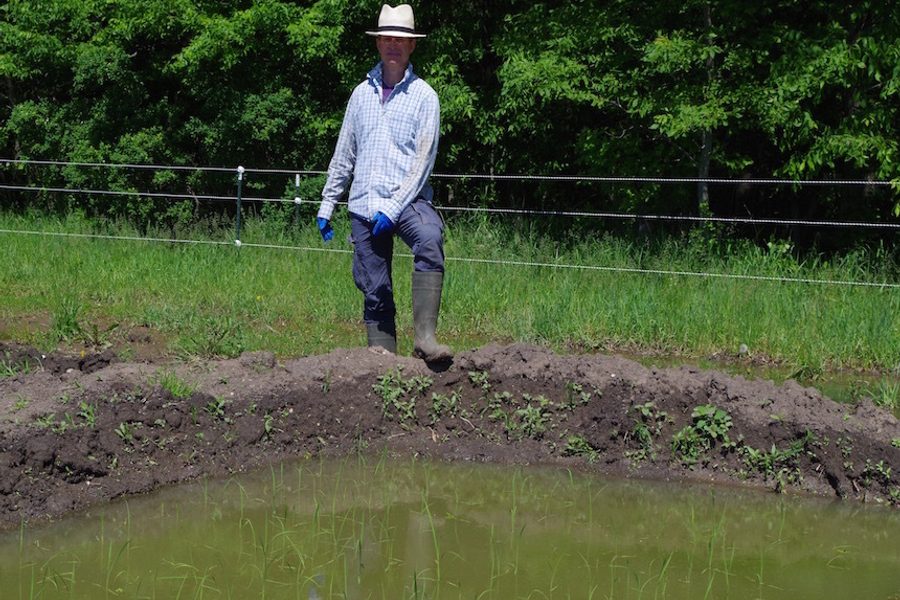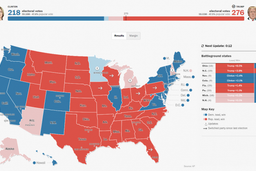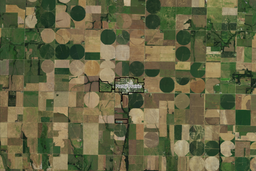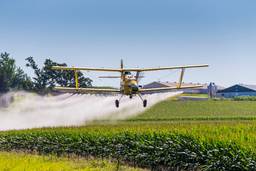
If you haven’t heard of the Wisconsin Rice Growers Association it’s because there isn’t one. In fact, when it comes to rice cultivation in the Dairy State, Michael Schläppi, a biology professor at the Marquette University, is the only person doing it.
“I’m the oddball,” says Schläppi, wearing waders and a full brim hat as he troubleshoots an irrigation issue on a small plot of farmland he’s leased in Port Washington, 25 miles north of Milwaukee.
He’s researching stress tolerance in plants, particularly cold tolerance in different strains of rice. More than 40,000 varieties are grown worldwide and some stand a better chance of thriving here than others. The capacity to endure cold is a must for any living organism considering roots in Wisconsin.
Schläppi has his reasons for experimenting with rice. “For starters,” he says, “it feeds about half of the world’s population.”
According to the US Rice Producers Association, 1 billion humans (besides Schläppi) actively cultivate rice on 500 million hectares — 11 percent of the world’s arable land. Meanwhile, 3 billion depend on rice as a dietary staple. Indeed, with the exception of sex, war and religion, the cultural significance of rice — its impact on civilization for thousands of years — is unparalleled.
“We buy ours, here in Wisconsin, from California or Arkansas,” says Schläppi.
The average American, ingests about 25 pounds of rice per year — four in the form of beer. About 80 percent of that rice is grown in California, Arkansas, Texas, Louisiana, Missouri and Mississippi. The rest, varieties such as jasmine and basmati, is imported largely from south and southeast Asia. And while the United States grows only 2 percent of the world’s rice, that which we export (mainly to Mexico, Central America, the Middle East, the Caribbean and Northeast Asia) constitutes over 10 percent of the global trade.
“Imagine the carbon footprint for it to travel these distances,” says Schläppi, “from California to Wisconsin alone.”
California, Calories and the Need for Water
As increased climate awareness solicits a hard look at the inefficiency (often absurdity) of certain global import/exports, the drought facing California, now in its fourth unrelenting year, calls into question the state’s ability to continue producing the crops on which the nation has come to depend. California farmers are scrambling, rotating what they grow and where, in an attempt to use, as efficiently as possible, the dregs of a water supply currently failing to (adequately) replenish itself.
This “unprecedented moisture deficit” (a term used by Richard Waycott, the President and CEO of the Almond Board of California) has gotten so bad that Tom “Magnum, P.I.” Selleck recently paid $21,685.55 to settle allegations he’d illegally trucked thousands of gallons from a public hydrant in Thousand Oaks to his nearby ranch in Hidden Valley. His plants were no doubt thirsty but California farmers have it even worse. Hundreds of thousands of acres of California farmland are sitting dry and idle, and the ripple effects of decreased production are crippling farming communities — real people whose livelihoods are contingent on the occasional rain. Fallow fields require as much labor as they do water: zero.
In April, Gov. Jerry Brown (D) issued a statewide emergency executive order to cut back water usage, the first order to do so in the state’s history.
“Today we are standing on dry grass where there should be five feet of snow,” said Brown at a speech in the Sierra Nevada. “This historic drought demands unprecedented action.”
The restrictions, however, applied largely to urban usage — exempting the state’s already struggling farmers. Critics, relishing the idiom drop in the bucket, pointed out that excluding from restrictions the industry responsible for 80 percent of the state’s water use would ultimately fail to affect meaningful conservation. In June, some senior water rights holders — those with claims to water usage dating back to the early 20th century — experienced their first mandatory cutbacks ever. In one Central Valley district, drawing water from the streams and rivers, historic fountains of wealth, has already resulted in fines in the millions of dollars.
Small farms that lack the resources and infrastructure to access the increasingly limited supply are hurting the most, but farmers across the board and, subsequently the state itself, stand to lose billions in revenue for the second year in a row. Because production costs represent only one of many factors considered in product pricing, some economists say consumers, at least for the moment, will be insulated from paying higher prices nationally. If transportation and packaging costs remain consistent, produce imported from other regions (and countries) can supplement the supply enough to keep up with demand. But what about the next five or 10 years? As debates surge in California — about everything from free market control of water to the need for desalinization technology — the lack of significant rainfall and the nonexistent snowpack in the Sierras persist.
Like corn, almonds and alfalfa (and humans in groups) rice requires large quantities of water to thrive. According to the California Rice Commission, because of the drought 175,000 fewer acres of rice are being planted in the Sacramento Valley than would be otherwise. To make matters physically worse, over-pumping of remaining groundwater in the region is causing the land itself to sink.
Given the increasing unpredictability of temperature and weather patterns, therefore, it’s not inconceivable that the future of domestic food production (for certain crops in particular) may require a regional shift to places where water is abundant. Perhaps, to places like Wisconsin.
As he stands next to a series of experimental paddies with shoots of young rice — a Russian variety he’s already had some success with on the rooftop of a building at the University of Marquette, Schläppi muses, “We could be the new California.”
Putting a Plan Into Action
Schläppi’s experiments are very much his own, but he has a network of urban and rural allies. The plot he’s renting in Port Washington is part of 80 acres leased and managed by Fondy Farms. Milwaukee’s Fondy Farmer’s Market, now in its 97th year, has a unique history (the subject of a forthcoming Rural America In These Times story), but the farmland itself is a relatively new addition. In 2010, the Fondy Farm Project, with grants from the USDA and private funding, was established to help provide affordable land and agricultural infrastructure to small farmers growing fresh, local, organic produce for Milwaukee’s North Side.
The majority of these farmers are part of the state’s 49,000 strong Hmong population — the third largest in the country. With tribal origins in the mountains of southern China, Hmong migrated to Laos, Thailand and Vietnam over the last three centuries. During the Vietnam War Hmong were recruited as spies by the CIA. In the wake of the communist take over, they were persecuted and slaughtered by the thousands. In 1976, Hmong refugees began seeking (and were granted) political asylum in the United States. Many settled in Wisconsin and the population continues to grow today.
For the Hmong, farming is a way of life. And centuries of agricultural knowledge — often employing unconventional methods by Western standards — have been passed down through generations. Among the 30 farmers selling their produce at Fondy Market this year, 11 are Hmong who farm leased plots at Fondy Farms.
For Schläppi, it’s a serendipitous arrangement.
“These are the people I want to work with,” he says, “because they know how to grow rice.”
For many small-scale operations, getting “certified organic” isn’t worth the time and money the current USDA bureaucracy mandates. Fondy Farms is no exception, though that doesn’t stop them from growing without the use of chemical pesticides. Strategies vary by plot and, at harvest time, the Fondy Farms visitor might be taken aback by the absence of organized rows or designated sections of land dominated by one specific crop. Hmong farmers have demonstrated that by broadcasting a mix of compatible seeds by hand (different kinds of greens, tomatoes with zuchinnis, peppers next to cantalopes) competition for sunlight is minimized. Meanwhile, insects looking for acres of their favorite crop are forced to look elsewhere.
Schläppi has already received helpful advice from Hmong farmers regarding his rice paddies — namely that he should think about digging longer, wider paddies, with a walkway down the middle, instead of the squares he’s currently working with.
“If it’s too wet the rice drowns,” says Schläppi. “Rice can be flooded but not submerged. And the reason people use paddies is because it gets rid of the weeds.”
For the sake of comparison, Schläppi is also growing rice above ground, like corn, with stalks planted in a row.
“I’m told the rice the yield will be lower,” says Schläppi, “But if we can do it in a way that gets rid of the weeds then it would be sustainable. We still have to think about this quite a bit.”
In exchange for the affordable lease — about $150 per acre per year, which Schläppi is paying for out of his limited research funds — Fondy farmers are required both to grow organically and sell a portion of their harvest at the Fondy Market. And that’s the plan for Wisconsin’s first rice crop.
“Our idea is to first sell brown rice at the Fondy Market,” says Schläppi, “It’s nutritious — people don’t always realize that.”
Because brown rice retains its embryo and a portion of its outer layer, it contains numerous essential amino acids and proteins that processed rice does not.
“Of course, most people want the white polished rice that gets rid of all this,” says Schläppi, “but that’s just starch basically — a comfort food.”
Worth noting, before any rice can be sold or consumed, it has to grow, be harvested and then hulled — a process that removes the hard shell covering the grain. Schläppi explains that although the machines that do this work for smaller farming operations are not unreasonably expensive (perhaps in the hundreds or low thousands of dollars), they are impossible to purchase in the United States.
While there’s an enormous rice industry in this country, nobody sells the gear needed for small-scale production. “The only market is overseas,” says Schläppi, “They don’t sell this equipment in the states. In China, Korea or India and Japan, even Brazil — yes — but then you need to get them over here. And that cost is tremendous.”
Schläppi’s solution is simple: “I work with an engineering professor at Marquette and he’s going to build, with his students, a prototype.”
Once complete, the design — essentially two rolling pins that grind against each other, a funnel and a fan to blow away the chaff — will just need some rice.








